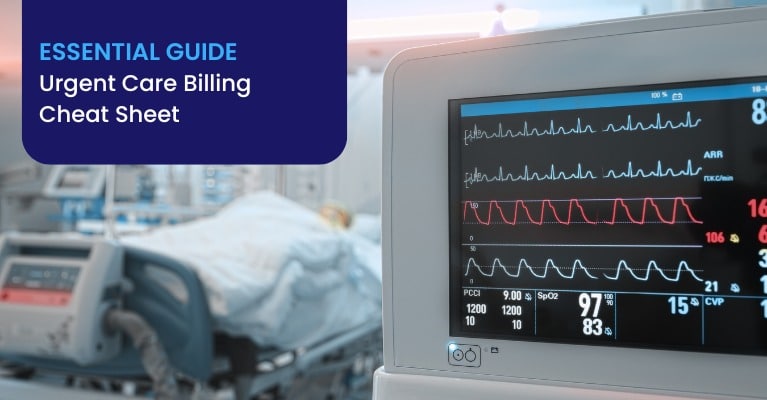
Menu

Accurate Billing in urgent care can be challenging for healthcare providers. Billing is a key component as it directly impacts financial healthcare. Over 60% of urgent care centers reported billing errors creating delayed payments in the past year.
Effective billing in urgent care includes the most commonly used CPT codes Evaluation and Management (E/M) visits, minor surgical procedures, and diagnostic services. Meanwhile, the correct usage of these codes and services not only ensures appropriate reimbursement but also prevents claim denials.
This urgent care billing cheat sheet will help to simplify this process. It includes key billing codes, documentation requirements, and best practices for using modifiers. With this guide, as a healthcare provider, you can improve your billing accuracy and enhance the financial health of your urgent care practice.
Recognizing the crucial elements of urgent care billing can help avoid mistakes and improve reimbursement rates.
These are the most often used CPT codes in urgent care settings, necessarily for accurate billing and reimbursement.
| Category | Procedure | CPT Codes | Description |
| Evaluation and Management (E/M) Codes | Patient Visits (New and Established) | 99202-99215 | Use for patient visits, including history, examination, and medical decision-making. |
| Procedure Codes | Suturing | 12001-13160 | Codes for suturing of wounds vary by complexity and location of the wound. |
| Splinting | 29000-29799 | Codes for application of splints for immobilization of fractures and dislocations. | |
| Diagnostic Tests (X-rays) | 71045-71048 | Codes for chest X-rays vary by the number of views taken. |
ICD-10 codes document certain diagnoses and conditions, ensuring the medical necessity for procedures is clear.
| Diagnosis | ICD-10 Code | Description |
| Sprain of unspecified ligament of right ankle | S93.401A | Injury involving a sprain of an unspecified ligament of the right ankle. |
| Acute upper respiratory infection, unspecified | J06.9 | Diagnosis for an acute upper respiratory infection of unspecified origin. |
Authentic documentation supports the services billed and prevents denials. This section covers the necessary documentation elements and common mistakes to avoid.
Correct documentation is essential for accurate billing and reducing the risk of claim denials. Here are the key elements that need to be documented:
Common documentation mistakes are necessary to prevent claim denials and ensure accurate reimbursement. Here are some frequent errors:
Modifiers provide additional details about a service, affecting reimbursement and claim processing. This section covers commonly used modifiers and their correct application.
Modifiers offer the essential information to clarify services performed. Here are some of the most frequently used modifiers in urgent care billing:
| Modifier | Description |
| -25 | Significant, separately identifiable evaluation and management service by the same physician on the same day of the procedure or other service. |
| -59 | Distinct procedural service indicates that a procedure or service was distinct or independent from other services performed on the same day. |
| -TC | The technical component is used when the technical part of a service is performed separately from the professional part. |
| -26 | A professional component is used when only the professional part of a service is provided. |
Applying modifiers accurately is essential for correct billing and avoiding denials. Here are the key points for using modifiers:
| Modifier | Correct Application |
| -25 | Attach this modifier when an E/M service is performed on the same day as a procedure, and the E/M service is significant and separately identifiable. |
| -59 | Use this modifier to indicate that a procedure is distinct from others performed on the same day. It should be used sparingly and only when necessary. |
| -TC | Apply this modifier when the technical component of a service, such as radiology, is billed separately from the professional component. |
| -26 | Use this modifier when billing for the professional component of a service, such as radiology, where the interpretation is performed separately from the technical component. |
Ensuring coverage and getting necessary preauthorization are critical steps in the billing process. This section covers the steps for verifying insurance and understanding preauthorization requirements.
Verifying patient insurance details before providing services helps prevent claim denials and billing issues.
Preauthorization is important for specific procedures and services to ensure the patient’s insurance.
Accurate billing is crucial for the financial health of urgent care centers. By recognizing and correctly applying CPT codes, documenting thoroughly, using appropriate modifiers, and ensuring insurance verification and preauthorization, healthcare providers can reduce billing errors and prevent claim denials. This “Urgent Care Billing Cheat Sheet” provides a beneficial resource for improving billing accuracy and efficiency, ultimately enhancing the financial stability of your practice.
The most common CPT codes include 99202-99215 for E/M visits, 12001-13160 for suturing, and 71045-71048 for X-rays.
Accurate documentation ensures proper billing, supports medical necessity, and prevents claim denials.
Modifiers provide additional details about services, affecting reimbursement and claim processing accuracy.
Collect insurance details at check-in, verify coverage, check benefits, identify preauthorization needs, and document verification.
Preauthorization ensures that specific procedures are covered by the patient’s insurance, preventing payment issues.



